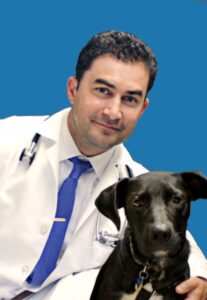-
Adopt
-
Veterinary Care
Services
Client Information
- What to Expect – Angell Boston
- Client Rights and Responsibilities
- Payments / Financial Assistance
- Pharmacy
- Client Policies
- Our Doctors
- Grief Support / Counseling
- Directions and Parking
- Helpful “How-to” Pet Care
Online Payments
Emergency: Boston
Emergency: Waltham
Poison Control Hotline
-
Programs & Resources
- Careers
-
Donate Now
 Rob Daniel, DVM, DACVIM (Neurology)
Rob Daniel, DVM, DACVIM (Neurology)
angell.org/neurology
neurology@angell.org
617-541-5140
Neuromuscular diseases can involve the spinal cord (neuron), nerve root and nerve, neuromuscular junction and muscle. Such diseases can be either acquired (immune-mediated, infectious) or inherited (muscular dystrophy). Regardless of the particular area of the motor unit? affected, clinical signs include a short-strided gait (sometimes bunny-hopping) and abnormal posture, with center of balance lower to ground (‘crouched’ stance).
Polymyositis, inflammation of more than one muscle group, has historically been used as a general term, including both immune-mediated and infectious etiologies. Recently, this particular term has taken on a more defined meaning in human medicine, referring specifically to inflammation that is auto-immune.
How to recognize polymyositis in your practice?
Weakness, often generalized, is the hallmark of polymyositis. Accompanying signs may include anorexia, regurgitation, ptyalism, dysphagia, dysphonia, changes in physical appearance to muscle (either swollen in acute phase, atrophic in chronic phase) that can either be generalized or focal (temporalis muscles in the Vizsla, tongue in the Pembroke Welsh Corgi) and lameness. Importantly, myalgia, or hyperesthesia upon muscle palpation, is not a hallmark of polymyositis. It is also noteworthy that temporalis muscle atrophy can be a clinical feature of polymyositis, in the absence of detectable Type IIM antibodies in the serum, negating a diagnosis of Masticatory Muscle Myositis. Spinal reflexes, namely patellar reflexes and withdrawal reflexes, may be normal or reduced. An inappropriate mentation, characterized by drowsiness, can be encountered secondary to pyrexia. Keeping polymyositis as a differential diagnosis for generalized weakness is the single, most important factor to maximize our chances of diagnosing this disease process.
Who gets polymyositis?
Although any dog or cat, of any age, any sex, can develop polymyositis-,there are some key signalments to be aware of. Breed-associated polymyositis has been recognized in Newfoundlands, Boxers, Pembroke Welsh Corgis and Vizslas. Large-breed dogs appear to be over-represented. Some unique situations exist in our literature with respect to signalments, such as Doberman Pinschers that have been given trimethoprim-sulfadiazine, dogs with concurrent neoplasia who develop polymyositis as a paraneoplastic effect or dogs with concurrent systemic lupus erythematosus.

Figure 1. A Pembroke Welsh Corgi showing the tongue atrophy seen in this breed-specific form of Polymyositis. (Symptomatic Tongue Atrophy Due to Atypical Polymyositis in a Pembroke Welsh Corgi Daisuke ITO1), Midori OKADA2,5), Nick D. JEFFERY3), Masato KITAGAWA1)*, Kazuyuki UCHIDA4) and Toshihiro WATARI1) 1)Nihon University, School of. J. Vet. Med. Sci. 71(8): 1063–1067, 2009
What’s happening in those muscles in Polymyositis?
The immune system on the whole targets muscle. Circulating auto-antibodies to sarcolemmal antigens in Newfoundlands, Boxers and Hungarian Vizslas and an increased risk of polymyositis in in major histocompatibility complex-2 (MHC-2) haplotype in the Hungarian Vizsla. Under the microscope, non-angular muscle fiber atrophy, myonecrosis and cellular infiltration, regenerating muscle fibers, the increased endo/perimysial connective tissue, muscle fibrosis and vacuolation of muscle fibers are all structural changes that can be seen. Histopathologically, B cells are rarely identified in muscle from individuals affected with polymyositis, unlike from those muscles suffering from Masticatory Muscle Myositis.
What tests can we do in our hospital to help us reach a presumptive diagnosis, without anything fancy?
A complete blood count, serum biochemistry, urinalysis is key to exclude anemia, glucose abnormalities and electrolyte abnormalities,namely (potassium, sodium, calcium, magnesium and phosphate). A serum creatine kinase (CK) level is critical as this is often elevated in inflammatory, as well as necrotizing and dystrophic myopathies. Importantly, the persistence and magnitude of elevations in this enzyme activity correlates with severity of muscle fiber disruption. Elevations in CK activity with polymyositis often have modest elevations, ranging from 2,000 to 20,000 IU/L. In addition, infectious disease testing, cardiac troponin I levels, acetylcholine receptor antibody levels, thyroid levels, lactate/pyruvate analysis and Type IIM antibodies can help discriminate polymyositis from other myopathies. A strong argument for surgical muscle biopsy early in the course of disease is often made, speaking both to reaching a definitive diagnosis as well as supporting a given prognosis.
How can we treat this disease?
Immune-suppressing medications are the hallmark of treatments, with an initial immunosuppressive dose of prednisone the cornerstone of therapy. Often a second (or potentially 3rd) immunomodulatory drug is added, to not only help provide a multimodal treatment approach but to help expedite the taper of prednisone, minimizing the serious side-effects that can be debilitating and potentially worse than the particular disease process being treated.
What is the prognosis?
Response to appropriate therapy is the best prognostic indicator we have in treating polymyositis. Making as timely a diagnosis as possible is so important, in order to minimize the degree of muscle fibrosis and muscle fiber loss. The prognosis is generally favorable.
Our board-certified team of Veterinary Neurologists here at Angell Animal Medical Center are here to help with consultations or any other questions that arise in Polymyositis.
Important Reference
Comparative Neuromuscular Laboratory; an excellent course for muscle diseases